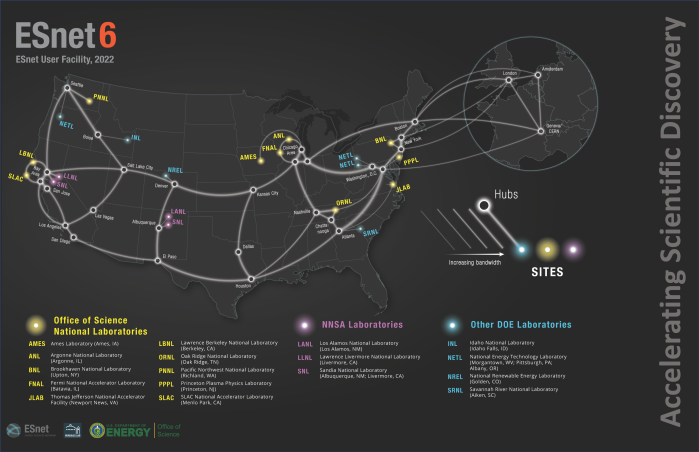Our Mission
In short, ESnet's Mission is to enable and accelerate scientific discovery by delivering unparalleled network infrastructure, capabilities, and tools.
ESnet's Vision is summarized as these three points:
- Scientific progress will be completely unconstrained by the physical location of instruments, people, computational resources, or data.
- Collaborations at every scale, in every domain, will have the information and tools they need to achieve maximum benefit from scientific facilities, global networks, and emerging network capabilities.
- ESnet will foster partnerships and pioneer the technologies necessary to ensure that these transformations occur.
ESnet provides high-bandwidth, reliable connections that link scientists at national laboratories, universities, and other research institutions, enabling them to collaborate on some of the world's most important scientific challenges, including energy, climate science, and the origins of the universe. Funded by the DOE Office of Science, ESnet is managed and operated by the Scientific Networking Division at Lawrence Berkeley National Laboratory. As a nationwide infrastructure and DOE User Facility, ESnet provides scientists with access to unique DOE research facilities and computing resources.
ESnet has a strong ethos of leadership in networking innovation. Our team is constantly improving the services to create a more versatile and robust network to serve the emerging needs of scientific researchers. We work closely with the international technical community to develop open-source software and collaborative technical projects. Our programs, as well as our collaborations with other research and education networks around the world, demonstrate our commitment to pushing network research forward so we will be able to anticipate and flawlessly serve the needs of DOE scientists.
As computational tools such as simulation and visualization become more fine-tuned and sophisticated, they also require the processing and management of greater amounts of data. The sheer volume of data generated by international scientific collaborations and the increasingly distributed nature of large data flows, as well as the development of real time cloud computing, is creating a staggering volume of network traffic. Since 1990, ESnet's average traffic has grown by a factor of 10 every 47 months. This growth trend is only accelerating as international scientific collaborations such as the Large Hadron Collider (LHC), Coupled Model Intercomparison Project (CMIP), and International Thermonuclear Experimental Reactor (ITER), generate and exchange massive amounts of data. ESnet provides a scalable and efficient network infrastructure that enables scientists to optimize their resources and conduct ambitious, world-class research.
ESnet is supervised by the Office of Science, which oversees 17 national laboratories and 28 user facilities that carry out the missions of its science programs, as well as underwrites research and development projects conducted at additional laboratories overseen by other DOE offices.

ESnet's nationwide backbone connects scientists across the U.S. and around the globe. (Select image to enlarge.) »Download the full-size ESnet network map.
The national laboratory system, created over a half-century ago, represents the most comprehensive research system of its kind in the world. National laboratories perform research that is not well suited to universities or the private sector because of its scope, infrastructure, or multidisciplinary nature but for which there is a strong public and national purpose. This is why ESnet exists – to provide the specialized kind of networking services required by multidisciplinary teams of scientists as they collaborate in distributed experiments using world-class scientific equipment, supercomputers, and facilities.

